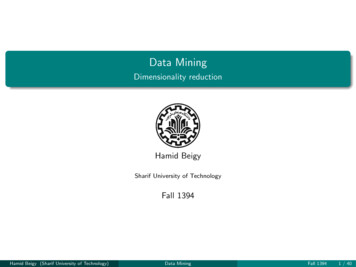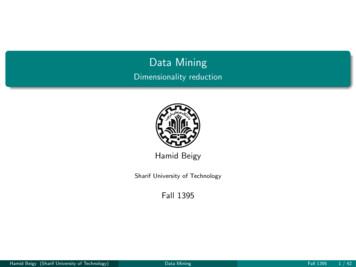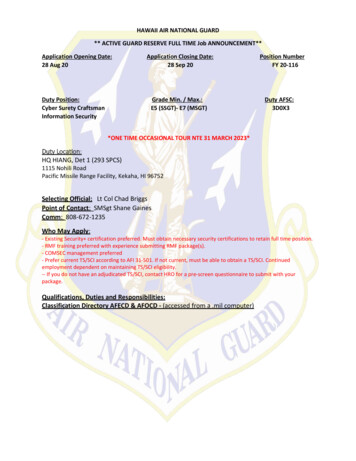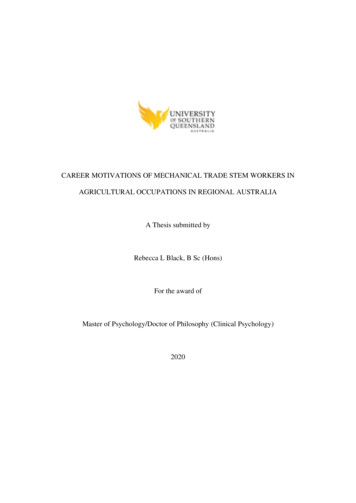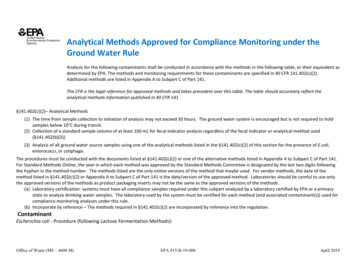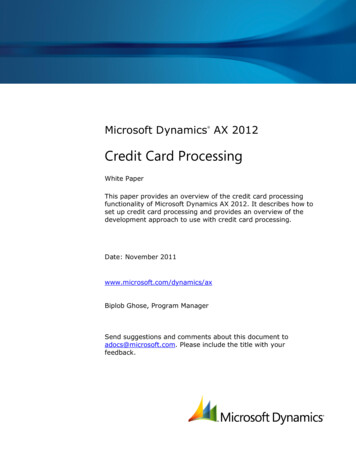
Transcription
UNCLASSIFIED18th Space Control SquadronThis Briefing is UNCLASSIFIED18 SPCS Methods ofProcessing Reentries ofSpace ObjectsZach Slatton, 18 SPCSDiana McKissock, 18 SPCSPatrick Adams, 18 SPCSTHIS BRIEFING IS FOR INFORMATION ONLY. NO U.S. GOVERNMENT COMMITMENT TO SELL, LOAN, LEASE, CO-DEVELOP OR COPRODUCE DEFENSE ARTICLES OR PROVIDE DEFENSE SERVICES IS IMPLIED OR INTENDED.UNCLASSIFIED0
UNCLASSIFIEDOverview DefinitionsBackgroundReentry ProcessingReentry Processing ToolsBreakupsReentry ConfirmationMessagingDifficult orbits for reentriesSpace-track.org productsUNCLASSIFIED1
UNCLASSIFIED18th Space Control SquadronMISSIONDeliver foundational Space SituationalAwareness to assure global freedom ofaction in space.VISIONGlobal innovator and leader providingunrivaled SSA through operationalexcellence.UNCLASSIFIED2
UNCLASSIFIEDSpace Surveillance NetworkSAPPHIRESBSSBlock 10STSSGSSAPSV 1-4THULEGLOBUS IICLEARFYLINGDALESCAVALIERGEODSS(site 2)MSSSLSSCCAPE CODBEALE18SPCS Det 1JSpOC/18 SPCSSST EGLINGEODSS(site 1)SocorroCOBRA DANEFuture SpaceFence (IOC FY19)RTSASCENSIONGEODSS (site 3)Diego GarciaSST (IOC FY18)HEH/C-BandTracking RadarOptical TelescopeDedicatedSSN C2Detection RadarSSN C2CollateralDedicated Int’lImaging RadarContributingUNCLASSIFIED3
UNCLASSIFIED18 SPCS DefinitionsREENTRY:Man-made object that reenters the Earth’s atmosphere and no longer remains in orbit3 Types of ReentriesDeorbitNormal DecayReentry Assessment(RA) ObjectsControlled reentry of anobject, usually at aknown time to a plannedlocation; not possible toprocess as RA objectUncontrolled, gradualreduction of an object’sorbit; not expected tosurvive reentry;typically RCS 1m2Portions of large ordense objects that maysurvive reentry throughthe atmosphere andimpact the Earth;Payload, R/B’s or Debris 1m2 or historicallyexpected to surviveUNCLASSIFIED4
UNCLASSIFIED18 SPCS Definitions, cont. Reentry Assessment (RA) - the process of maintaining the TLEsof reentering objects, predicting the point and time of reentry,and notifying the appropriate international agencies and thepublic of the predictionsRA objects can:– Damage people or property– Trigger missile warningsRA objects categorized as High Interest if:––––––Historically significantDeemed significant by a higher authorityHistorically survivable or RCS 10m2Garners significant media interestHas a radioactive/nuclear payload or power sourceContains human remainsUNCLASSIFIED5
UNCLASSIFIEDBackgroundArticle 3 of the 1971 “Agreement on Measures toReduce the Risk of Outbreak of Nuclear Warbetween the United States of America and theUnion of Soviet Socialist Republics” states that“The Parties undertake to notify each otherimmediately in the event of detection by missilewarning systems of unidentified objects.”UNCLASSIFIED6
UNCLASSIFIED18 SPCS Reentry Processing Tools SPADOC SP ASW SP– Used for real-time event processing– State vector built off of SGP4 TLEs when RA is initialized and maintaineduntil final prediction run is complete– Reentry prediction based off of a propagation to altitude of 10 kmabove Earth’s surface– Can be extremely slow and difficult to get states to converge– Used for analysis and determining when an RA should be initialized– More up-to-date force models» Earth Models» Dynamic Calibration Atmosphere (DCA)– Higher accuracy– Faster and states converge easierUNCLASSIFIED7
UNCLASSIFIEDReentry Processing Tools (cont.) SGPE– Program written by AFSPC– Semi-analytic– Does a least-squares fit to TLEs to determine average BallisticCoefficient– Used with dynamic atmosphere model to propagate to decay– Can be more accurate and timely than SP for near-earth circular– Used for normal decaysUNCLASSIFIED8
UNCLASSIFIEDReentry Processing All objects are screened Mon-Fri for decay status Highly eccentric orbits:Near-earth circular orbits:– SGP4 propagations for 60 days––––Database queryPerigee height less than 250 km for near earthPerigee height less than 200 km for deep spaceAnalyst determine likelihood of decay and adds to list for initializationUNCLASSIFIED9
UNCLASSIFIEDReentry Processing (cont.) Reentering objects that qualify for RA are initialized 7 to 14days before predicted reentry– Six part folder created, includes: All ground traces, run logs, messages,and state vectors– Sensor tasking upgraded– SPADOC SP state vector created Required runs Monitor runs– Required runs entail updating the state, running decay prediction, andtransmitting appropriate messages– Done at 4, 3, 2, 1-day, and 12, 6, 2-hour points and post decay (Final)– Done when new sensor observations acquired– Keeps the state up-to-date– Updates prediction time; no message transmittedUNCLASSIFIED10
UNCLASSIFIEDGround Trace of F-1, 38855UNCLASSIFIED11
UNCLASSIFIEDReentry Breakups Objects may fragment before reentry Objects may fragment multiple timesRA Officer creates whatever pieces possibleMany times pieces will reenter before they can be createdPieces tasked for radar cross section (RCS)– Used to determine if still large enough to be considered RAObjects that fragment within 6 hours of predicted reentry timeand cross CIS or Southwest Asia are reported to higherheadquartersUNCLASSIFIED12
UNCLASSIFIEDReentry Confirmation Sensors tasked to perform POS/NEG reporting after predictedreentry timeConfirmation done with visual information (when available)– Correlated with ephemeris– Reported as official time of reentry1 no-show required from sensors if visual information isreceived3 no-shows required from sensors if no visual information isreceivedAlternatively, RA Officer may deem an object reenteredAfter reentry is confirmed, sensors de-tasked via DecayMessageUNCLASSIFIED13
UNCLASSIFIED18 SPCSgenerates weeklyreentry anddecay predictionsusing GP data.60 DayReentry/Decay Sensor taskingincreased Reentryassessmentrun once perday4 1 Sensor taskingincreased Reentryassessmentrun once every8 hoursTIP: 1/dayUNCLASSIFIED12, 6, 2Reentryassessments runat 12, 6, and 2hour pointsTIP at each RA updateHOUR7 5Special PerturbationHOUR60 7DAYDAYGeneral PerturbationDAY18 SPCS Reentry Process0 Sensors taskedto search /- 2mins of taskingcriteria Sensorsreports noshow to 18SPCSFinal TIP after3 no-shows14
UNCLASSIFIEDMessaging Tracking and Impact Prediction (TIP) Tasking TIP Alert (available on Space-Track.org) OPREP-3 advance notification Two hour Missile Warning Message– Sent to SSN as a direction to increase tasking– 2-day and 1-day point– Contains Time, Latitude, and longitude of reentry– Sent after every required update– Sent to state department and disseminated appropriately– Sent at the six hour, two hours, and final runs– Tips Missile Warning agencies– Sent at the 2-hour pointUNCLASSIFIED15
UNCLASSIFIEDRequired Runs and MessagesRequired RunAdditional ActionsMessages Sent4 DayInitialize ReentryTIP Alert3 DayN/ATIP Alert2 DayASW Crosscheck*, UpgradeTaskingTIP Alert, TIP Tasking1 DayASW Crosscheck*, Upgrade TIP Alert, TIP TaskingTasking, Geocentric crossinganalysis (GCA)12 HourASW Crosscheck*, GCA*,Voice task sensorsTIP Alert6 HourASW Crosscheck*, GCA*TIP Alert, OPREP-3*2 HourASW Crosscheck*, GCA*,print no-show reports,Voice Task sensorsTIP Alert, OPREP-3*, 2-hrMissile Warning* If requiredUNCLASSIFIED17
UNCLASSIFIEDDifficult Orbits for Reentry High-eccentricity––––Sensors use SGP4 TLEsUncorrelated observationsMore likely to break up due to higher drag forcesPerigee skip» Can push out reentry time for weeks or years Catastrophic decay Low Inclination– Extremely high eccentricity– Period can decrease over 20 mins/day– Poor sensor coverage– Can also be high eccentricityUNCLASSIFIED18
UNCLASSIFIEDPerigee “Skip” of DOUBLESTAR pieceUNCLASSIFIED19
UNCLASSIFIEDDifficult Orbits for Reentry (cont.) Objects with extremely high periods (multi-days)––––––––Highly inclinedPeriod 2 daysLunar perturbations cause eccentricity to changeObjects do not decay, they run into the earthHighly accurate reentry predictionsGRANAT and rocket body (20352 and 20354)INTERBOL 1 and rocket body (23632 and 23635)WT1190F» Likely leftover from a translunar mission» Prediction off by 15 secs» Used a network of asteroid tracking telescopes to trackUNCLASSIFIED20
UNCLASSIFIEDReentry of WT1190FUNCLASSIFIED21
UNCLASSIFIEDDifficult Orbits for Reentry (cont.) Catastrophic Decays: inclined geosynchronous orbits/Tundraorbits– Geosynchronous orbits with much shorter lifetimes than equatorialorbits– Inclination in the 55 to 65 degree range– Lunar perturbations cause eccentricity to change» Causes perigee to dip extremely low into atmosphere– Period can decay hundreds of minutes per day– Can cause perigee skip» Might push decay out by years– ELEKTRON 2 and rocket body (00748, 00751)UNCLASSIFIED22
UNCLASSIFIEDCatastrophic Decay of ELEKTRON 2, 00748UNCLASSIFIED23
UNCLASSIFIEDCatastrophic Decay of SL-3 R/B, 00751UNCLASSIFIED24
UNCLASSIFIEDSpace-Track.org Reentry Products Reentries are a basic service provided to registered users TIP Alert Decay Message60-Day Decay message– Posted once a week on Wednesdays– First done with SGP4 prediction– May be overwritten with SP prediction if one has been done– Posted after the required runs– SP prediction– Only done for objects that meet RA criteria– Posted when object is decayed– For an RA, done after the final runUNCLASSIFIED25
UNCLASSIFIEDSpace-Track.org Reentry TabUNCLASSIFIED26
UNCLASSIFIEDTIP Alert MessageUNCLASSIFIED27
UNCLASSIFIEDASW Ground Trace of OSNSAT, 41939UNCLASSIFIED28
UNCLASSIFIED18th Space Control SquadronThank you!UNCLASSIFIED29
Sensors tasked to perform POS/NEG reporting after predicted . - GRANAT and rocket body (20352 and 20354) - INTERBOL 1 and rocket body (23632 and 23635) - WT1190F » Likely leftover from a translunar mission » Prediction off by 15 secs » Used a network of asteroid tracking telescopes to track. 21.
